

Search for information on how to set up your Amazon store, and you’ll come across pages of results for keyword tools, search trend data, and Amazon seller e-commerce consultants making a pitch. But what too many of these resources leave out is that there are two audiences you need to tailor your store for: the Amazon algorithm and actual human beings.
You can optimize — and even over-optimize — all you want for bots and crawlers to boost your ranking, but don’t make the mistake of doing so without considering what actual Amazon shoppers are drawn to.
Obviously, you want your listing to be featured prominently so that more people will look at it. But if those people look at your listing and then leave, Amazon’s A10 algorithm lowers your ranking. Conversely, if just a few people look at and then interact with your listing or buy your product, A10 takes notice and boosts your listing. People and search engines work off each other, hence the need to appeal to both.
Here are a few ways to optimize your Amazon product listings to be successful not only with search engines but with real people too.
Amazon’s A10 algorithm thinks in keywords and straightforward descriptors of what a product is or does. But humans are drawn to brand names that are short and distinct. If you’re lucky enough to have customers talk about you or recommend your products to a friend, they’ll do so by mentioning your brand name — if it’s catchy.
When you look at successful listings, the page title usually combines two things:
The keywords are the easy part. But how do you know if your name is strong?
Naming your Amazon store and products is not an exercise you should do alone. Get outside perspectives.
Getting valuable feedback on your brand name is easy with instant polling software like PickFu. With PickFu, you create a survey question and choose the kind of people you want to poll. You can target respondents according to demographic and behavioral traits such as
You can even narrow your audience solely to Amazon Prime members.
In a matter of minutes, the results of your survey arrive in your inbox. No keyword tool can give you insights like the ones you’ll find in the written comments. The detailed feedback will provide you a clear understanding of whether your brand name is one that customers and potential customers will remember, return to, and recommend to others.
Product photography is the closest a customer can come to experience your product before buying it. A customer’s eyes are naturally drawn to the product’s image before anything else, even the product title. Often, your primary photo is what compels someone to click. For these reasons, your product photography is an essential element of your listings.
When a shopper performs a search on Amazon, your product’s main photo may significantly alter its clickthrough rate, for good or ill. Choosing this featured image, therefore, should not be left to chance. Split testing your photo removes any uncertainty.
In a traditional split test, you direct half of your traffic to one version of your page and the other half to a second version of that page and collect data from each.
Split testing works a little differently on Amazon in that you rotate the versions you are testing over a set period. In other words, you’d test your listing with one product image for a week, then try the listing with the other picture of that product.
It’s worth noting that you have to meet a minimum sales threshold to do a live split test on Amazon. It takes days, if not weeks, to gather that data. Also, you risk losing sales if your new image variant performs poorly while the listing is live.
The PickFu platform enables you to split test product images privately with an unbiased pool of respondents that closely resembles your target market. Results come back in about 15 minutes, which you can use to iterate and improve your photography quickly — and test again if need be. You can experiment with different angles and cropping to see if those changes make a difference in how potential customers view your product
When Amazon seller, Bumblebee Linens, ran a PickFu poll to test an existing product photo against a newly styled one, female respondents overwhelmingly preferred the new image. Once Bumblebee Linens updated the listing with the new picture, sales of the item jumped 209%.

You should optimize your photos for search engines, too. File size, naming conventions, and meta information such as alt tags will all help the bots and crawlers to understand what your photos contain.
Manufacturer’s product descriptions are duplicated across the internet, making it challenging to rank on Amazon. Instead, take the time to create original descriptions for your Amazon listings, and your SEO efforts will be rewarded.
With two product descriptions on an Amazon listing (the bullet points just under the product title and a longer blurb further down the page), remember that customers focus on the bullets first, and therefore so should you.
Don’t only list the features of your product. Show customers how they can use the product and why it’s worth their money.
Running a split test of your product descriptions, whether as a traditional live test on Amazon or a polling platform such as PickFu, will help you understand the words and phrases that are most meaningful to your audience, as well as any you should avoid.

For more info about split testing on Amazon listing, watch John Li’s Episode below:
Kim Kohatsu is the chief marketing officer at PickFu, an online service that e-commerce entrepreneurs use to know what sells before they sell it. With over 20 years in advertising and marketing, Kim knows how to appeal to customers. In her role as CMO, Kim helps brands use PickFu to write better copy, present products in their best light, and position themselves as market leaders.

Kim Kohatsu is the chief marketing officer at PickFu, an online service that e-commerce entrepreneurs use to know what sells before they sell it. With over 20 years in advertising and marketing, Kim knows how to appeal to customers. In her role as CMO, Kim helps brands use PickFu to write better copy, present products in their best light, and position themselves as market leaders.
Get notified with new podcast episodes every week! Plus, actionable and practical eCommerce tips straight to your inbox.
No spam. Unsubscribe anytime.